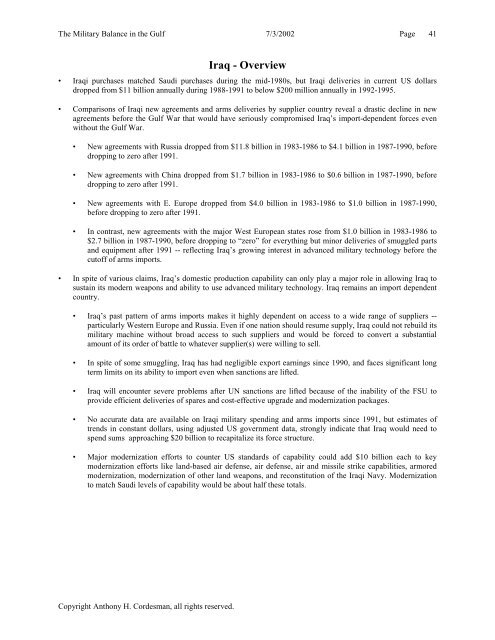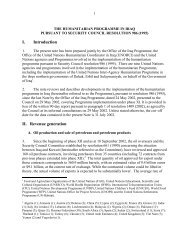If We Fight Iraq: Iraq and The Conventional Military ... - Iraq Watch
If We Fight Iraq: Iraq and The Conventional Military ... - Iraq Watch
If We Fight Iraq: Iraq and The Conventional Military ... - Iraq Watch
You also want an ePaper? Increase the reach of your titles
YUMPU automatically turns print PDFs into web optimized ePapers that Google loves.
<strong>The</strong> <strong>Military</strong> Balance in the Gulf 7/3/2002 Page41<strong>Iraq</strong> - Overview• <strong>Iraq</strong>i purchases matched Saudi purchases during the mid-1980s, but <strong>Iraq</strong>i deliveries in current US dollarsdropped from $11 billion annually during 1988-1991 to below $200 million annually in 1992-1995.• Comparisons of <strong>Iraq</strong>i new agreements <strong>and</strong> arms deliveries by supplier country reveal a drastic decline in newagreements before the Gulf War that would have seriously compromised <strong>Iraq</strong>’s import-dependent forces evenwithout the Gulf War.• New agreements with Russia dropped from $11.8 billion in 1983-1986 to $4.1 billion in 1987-1990, beforedropping to zero after 1991.• New agreements with China dropped from $1.7 billion in 1983-1986 to $0.6 billion in 1987-1990, beforedropping to zero after 1991.• New agreements with E. Europe dropped from $4.0 billion in 1983-1986 to $1.0 billion in 1987-1990,before dropping to zero after 1991.• In contrast, new agreements with the major <strong>We</strong>st European states rose from $1.0 billion in 1983-1986 to$2.7 billion in 1987-1990, before dropping to “zero” for everything but minor deliveries of smuggled parts<strong>and</strong> equipment after 1991 -- reflecting <strong>Iraq</strong>’s growing interest in advanced military technology before thecutoff of arms imports.• In spite of various claims, <strong>Iraq</strong>’s domestic production capability can only play a major role in allowing <strong>Iraq</strong> tosustain its modern weapons <strong>and</strong> ability to use advanced military technology. <strong>Iraq</strong> remains an import dependentcountry.• <strong>Iraq</strong>’s past pattern of arms imports makes it highly dependent on access to a wide range of suppliers --particularly <strong>We</strong>stern Europe <strong>and</strong> Russia. Even if one nation should resume supply, <strong>Iraq</strong> could not rebuild itsmilitary machine without broad access to such suppliers <strong>and</strong> would be forced to convert a substantialamount of its order of battle to whatever supplier(s) were willing to sell.• In spite of some smuggling, <strong>Iraq</strong> has had negligible export earnings since 1990, <strong>and</strong> faces significant longterm limits on its ability to import even when sanctions are lifted.• <strong>Iraq</strong> will encounter severe problems after UN sanctions are lifted because of the inability of the FSU toprovide efficient deliveries of spares <strong>and</strong> cost-effective upgrade <strong>and</strong> modernization packages.• No accurate data are available on <strong>Iraq</strong>i military spending <strong>and</strong> arms imports since 1991, but estimates oftrends in constant dollars, using adjusted US government data, strongly indicate that <strong>Iraq</strong> would need tospend sums approaching $20 billion to recapitalize its force structure.• Major modernization efforts to counter US st<strong>and</strong>ards of capability could add $10 billion each to keymodernization efforts like l<strong>and</strong>-based air defense, air defense, air <strong>and</strong> missile strike capabilities, armoredmodernization, modernization of other l<strong>and</strong> weapons, <strong>and</strong> reconstitution of the <strong>Iraq</strong>i Navy. Modernizationto match Saudi levels of capability would be about half these totals.Copyright Anthony H. Cordesman, all rights reserved.
















